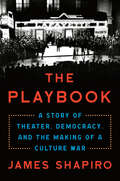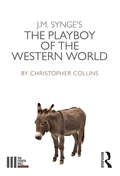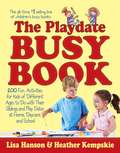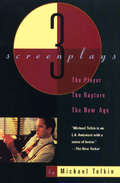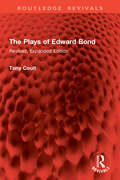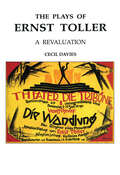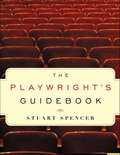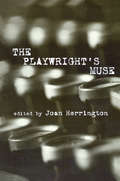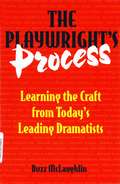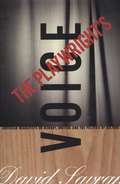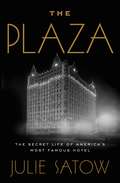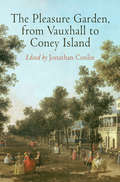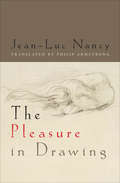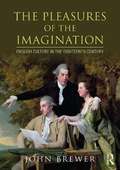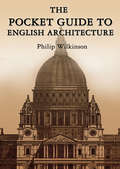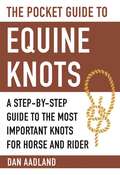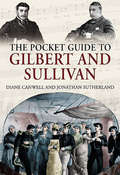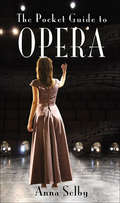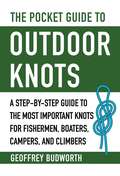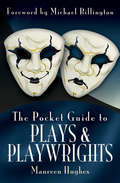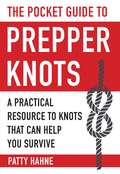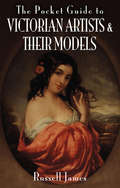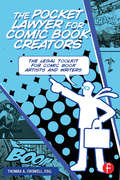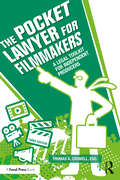- Table View
- List View
The Playbook: A Story of Theater, Democracy, and the Making of a Culture War
by James ShapiroA brilliant and daring account of a culture war over the place of theater in American democracy in the 1930s, one that anticipates our current divide, by the acclaimed Shakespeare scholar James ShapiroFrom 1935 to 1939, the Federal Theatre Project staged over a thousand productions in 29 states that were seen by thirty million (or nearly one in four) Americans, two thirds of whom had never seen a play before. At its helm was an unassuming theater professor, Hallie Flanagan. It employed, at its peak, over twelve thousand struggling artists, some of whom, like Orson Welles and Arthur Miller, would soon be famous, but most of whom were just ordinary people eager to work again at their craft. It was the product of a moment when the arts, no less than industry and agriculture, were thought to be vital to the health of the republic, bringing Shakespeare to the public, alongside modern plays that confronted the pressing issues of the day—from slum housing and public health to racism and the rising threat of fascism. The Playbook takes us through some of its most remarkable productions, including a groundbreaking Black production of Macbeth in Harlem and an adaptation of Sinclair Lewis&’s anti-fascist novel It Can&’t Happen Here that opened simultaneously in 18 cities, underscoring the Federal Theatre&’s incredible range and vitality. But this once thriving Works Progress Administration relief program did not survive and has left little trace. For the Federal Theatre was the first New Deal project to be attacked and ended on the grounds that it promoted &“un-American&” activity, sowing the seeds not only for the McCarthyism of the 1950s but also for our own era of merciless polarization. It was targeted by the first House un-American Affairs Committee, and its demise was a turning point in American cultural life—for, as Shapiro brilliantly argues, &“the health of democracy and theater, twin born in ancient Greece, have always been mutually dependent.&”A defining legacy of this culture war was how the strategies used to undermine and ultimately destroy the Federal Theatre were assembled by a charismatic and cunning congressman from East Texas, the now largely forgotten Martin Dies, who in doing so pioneered the right-wing political playbook now so prevalent that it seems eternal.
The Playboy of the Western World (The Fourth Wall)
by Christopher Collins‘I’m thinking this night wasn’t I a foolish fellow not to kill my father in years gone by.’ – Christy Mahon On the first night of J. M. Synge’s The Playboy of the Western World (1907) the audience began protesting in the theatre; by the third night the protests had spilled onto the streets of Dublin. How did one play provoke this? Christopher Collins addresses The Playboy ’s satirical treatment of illusion and realism in light of Ireland’s struggle for independence, as well as Synge’s struggle for artistic expression. By exploring Synge’s unpublished diaries, drafts and notebooks, he seeks to understand how and why the play came to be. This volume invites the reader behind the scenes of this inflammatory play and its first performances, to understand how and why Synge risked everything in the name of art.
The Playdate Busy Book
by Heather Kempskie Lisa HansonIn The Playdate Busy Book (previously titled The Siblings' Busy Book) authors Hanson and Kempskie have outlined 200 activities that all the kids can enjoy together (ages 3 months to 9 years). Each activity write-up includes ways for babies, toddlers, preschoolers, and school-age kids to join in the fun. As in other Busy Books, the activities range from arts & crafts, seasonal decorating, outdoor adventures, and imagination stretchers to making music, learning together, and rainy-day family fun.
The Player, The Rapture, The New Age: Three Screenplays (Books That Changed the World)
by Michael TolkinThree film scripts, including an Academy Award nominee, from the man described as an “Antonioni with a sense of humor” (The New Yorker). From his earliest works to the Emmy-nominated Showtime limited series Escape at Dannemora, Michael Tolkin is known as one of the industry’s biggest talents—and sharpest satirists. This volume contains three of his acclaimed screenplays. The Player, about the twisted world of Hollywood, was directed by Robert Altman and starred Tim Robbins and Greta Scacchi. It won an Edgar Award for Best Motion Picture Screenplay and has been hailed as “one of the smartest, funniest, most penetrating movies about moviemaking ever made” (Vanity Fair).The Rapture explores the emotionally intense, surreal world of Christian fundamentalism. The Los Angeles Times called it “a nervy, unsettling, edgy piece of work, that most audacious of cinematic ventures, a film of theological ideas, intent on looking into what we believe and why we believe it, determined, even eager, to explore the issues of heaven, hell, and the hereafter.”And The New Age tells the story of a young couple’s fall from financial grace and their quest for spirituality in a world defined by materialism.
The Plays of Edward Bond: Revised, Expanded Edition (Routledge Revivals)
by Tony CoultFirst published in 1977, The Plays of Edward Bond offers help and stimulation to readers and theatre-goers who want to know more about Edward Bond's recurrent concerns as a playwright. In attempting to counter much of the received critical opinion about Bond’s work, Tony Coult sets out to show how Bond’s attitudes to religion and superstition, nature and politics, the family and the individual are given brilliant theatrical form in the plays. There are, too, chapters on the plays in performance, dealing with language and stagecraft, and on the often stormy history of Bond’s relationship with the British Theatre. This makes for a fresh and unusual approach to a playwright’s work, and one particularly situated to the closely related rational theatre of Edward bond. This is a must read for scholars and researchers of theatre and performance studies and British theatre.
The Plays of Ernst Toller: A Revaluation
by Cecil DaviesThis book is the fullest and most detailed study yet published in English of Ernst Toller's plays and their most significant productions. In particular the productions directed by Karl-Heinz Martin, Jurgen Fehling and Erwin Piscator are closely analyzed and the author demonstrates how, brilliant though they were, they obscured or even distorted Toller's intentions. The plays are seen as eminently stage-worthy while worth lies in Toller's use of language, both in prose and inverse. The neglected puppet-play The Scorned Lovers' Revenge is analyzed from a new perspective in the light, both of its language and its sexual theme, so important in Toller's writings as a whole. The reader is led to appreciate why Toller was regarded as the most outstanding German dramatist of his generation until, after his death in 1939 his reputation was overlaid by that of Brecht. This book should do much to restore Toller to his proper place in theatre history.
The Playwright's Guidebook: An Insightful Primer On The Art Of Dramatic Writing
by Stuart SpencerA concise guide to playwriting to awaken creativity, from a playwright who has taught the subject for over a decade.“If you want to be a playwright, here’s your bible.” —David Lindsay-Abaire, author of Fuddy Meers and Wonder of the WorldDuring the more than ten years that Sturt Spencer has taught playwriting, he has struggled to find an effective handbook for his courses. Although most of the currently popular guides contain useful ideas, they all suffer from the same problems: poor organizations; quirky, idiosyncratic advice; and abstract theorizing on the nature of art. As a result, they fail to offer any concrete information or useful guidelines on how to construct a well-written play. Moreover, few of these books are actually written by working playwrights. Out of frustration, Spencer wrote his own. The result, The Playwright’s Guidebook, is a concise and engaging handbook full of the kind of wisdom that comes naturally with experience. Spencer presents a coherent way of thinking about playwriting that addresses the important principles of structure, includes insightful writing exercises that build upon one another, explores the creative process, and troubleshoots recurrent problems that playwrights actually face.“The Playwright’s Guidebook is indispensable. Clearly and thoroughly, Mr. Spencer—a playwright himself—leads all playwrights (not only the beginner) through the travails of creation and the jungle of production.” —Edward Albee“Eureka! A clearly written, well-structured, intelligent how-to book about playwriting. Like the good teacher and good writer that he is, Stuart Spencer guides rather than browbeats. Should be next to the laptop of any aspiring, or working, playwright.” —Warren Leight, author of Side Man
The Playwright's Muse (Studies in Modern Drama #Vol. 13)
by Joan HerringtonFirst Published in 2002. Routledge is an imprint of Taylor & Francis, an informa company.
The Playwright's Process: Learning the Craft from Today's Leading Dramatists
by Buzz MclaughlinThis guide aims to teach the reader the craft of writing and producing stage drama. The book covers such topics as script format, arranging readings, contacting agents, and getting a full production. How to build a good plot, and producing a piece that will work on stage are also examined.
The Playwright's Voice
by David SavranThis new volume of interviews with contemporary playwrights attests to the fact the dramatic art is alive and well in America and celebrates the art and talent of fifteen of the theatre's most important artists. In extensive interviews, they discuss their work, influences and their craft and how the art form relates to our cultural heritage, as well as the state of theatre-its-meaning and purposes as we approach the 21st Century. David Savran lays out their remarkable achievements and provides telling insights to their work in his substantial introductions to each interview.Interviews with: Edward AlbeeJon Robin BaitzPhilip Kan GotandaHolly HughesTony KushnerTerrence McNallySuzan-Lori ParksJosé RiveraNtozake ShangeNicky SilverAnna Deavere SmithPaula VogelWendy WassersteinMac Wellman and George C. Wolfe.
The Plaza: The Secret Life of America's Most Famous Hotel
by Julie SatowJournalist Julie Satow's thrilling, unforgettable history of how one illustrious hotel has defined our understanding of money and glamour, from the Gilded Age to the Go-Go Eighties to today's Billionaire Row. p.p1 {margin: 0.0px 0.0px 0.0px 0.0px; font: 12.0px Arial} p.p2 {margin: 0.0px 0.0px 0.0px 0.0px; text-indent: 36.0px; font: 12.0px Arial} From the moment in 1907 when New York millionaire Alfred Gwynne Vanderbilt strode through the Plaza Hotel's revolving doors to become its first guest, to the afternoon in 2007 when a mysterious Russian oligarch paid a record price for the hotel's largest penthouse, the eighteen-story white marble edifice at the corner of Fifth Avenue and 59th Street has radiated wealth and luxury. For some, the hotel evokes images of F. Scott Fitzgerald frolicking in the Pulitzer Fountain, or Eloise, the impish young guest who pours water down the mail chute. But the true stories captured in THE PLAZA also include dark, hidden secrets: the cold-blooded murder perpetrated by the construction workers in charge of building the hotel, how Donald J. Trump came to be the only owner to ever bankrupt the Plaza, and the tale of the disgraced Indian tycoon who ran the hotel from a maximum-security prison cell, 7,000 miles away in Delhi. In this definitive history, award-winning journalist Julie Satow not only pulls back the curtain on Truman Capote's Black and White Ball and The Beatles' first stateside visit-she also follows the money trail. THE PLAZA reveals how a handful of rich, dowager widows were the financial lifeline that saved the hotel during the Great Depression, and how, today, foreign money and anonymous shell companies have transformed iconic guest rooms into condominiums that shield ill-gotten gains-hollowing out parts of the hotel as well as the city around it.THE PLAZA is the account of one vaunted New York City address that has become synonymous with wealth and scandal, opportunity and tragedy. With glamour on the surface and strife behind the scenes, it is the story of how one hotel became a mirror reflecting New York's place at the center of the country's cultural narrative for over a century.
The Pleasure Garden, from Vauxhall to Coney Island
by Jonathan ConlinSummers at the Vauxhall pleasure garden in London brought diverse entertainments to a diverse public. Picturesque walks and arbors offered a pastoral retreat from the city, while at the same time the garden's attractions indulged distinctly urban tastes for fashion, novelty, and sociability. High- and low-born alike were free to walk the paths; the proximity to strangers and the danger of dark walks were as thrilling to visitors as the fountains and fireworks. Vauxhall was the venue that made the careers of composers, inspired novelists, and showcased the work of artists. Scoundrels, sudden downpours, and extortionate ham prices notwithstanding, Vauxhall became a must-see destination for both Londoners and tourists. Before long, there were Vauxhalls across Britain and America, from York to New York, Norwich to New Orleans.This edited volume provides the first book-length study of the attractions and interactions of the pleasure garden, from the opening of Vauxhall in the seventeenth century to the amusement parks of the early twentieth. Nine essays explore the mutual influences of human behavior and design: landscape, painting, sculpture, and even transient elements such as lighting and music tacitly informed visitors how to move within the space, what to wear, how to behave, and where they might transgress. The Pleasure Garden, from Vauxhall to Coney Island draws together the work of musicologists, art historians, and scholars of urban studies and landscape design to unfold a cultural history of pleasure gardens, from the entertainments they offered to the anxieties of social difference they provoked.
The Pleasure in Drawing
by Jean-Luc NancyThe renowned philosopher contemplates the medium of drawing in &“a book full of dazzling insights, imaginative curves and provocative renewals&” (Sarah Clift, University of King&’s College). In 2007, philosopher Jean-Luc Nancy curated an exhibition at the Museum of Fine Arts in Lyon. This book, originally written for that exhibition, explores the interplay between drawing and form—viewing the act of drawing as a formative force. Recalling that the terms &‘drawing&’ and &‘design&’ were once used interchangeably, Nancy notes that drawing designates a design that remains without project, plan, or intention. His argument offers a way of rethinking a number of historical terms (sketch, draft, outline, plan, mark, notation), which includes rethinking drawing in its graphic, filmic, choreographic, poetic, melodic, and rhythmic senses. For Nancy, drawing resists any kind of closure, and therefore never resolves a tension specific to itself. Drawing allows the gesture of a desire that remains in excess of all knowledge to come to appearance. Situating drawing in these terms, Nancy engages a number of texts in which Freud addresses the force of desire in the rapport between aesthetic and sexual pleasure, texts that also turn around questions concerning form in its formation. Between sections of his text, Nancy includes a series of &“sketchbooks&” on drawing, composed of quotations on art from different writers, artists, or philosophers.
The Pleasures of the Imagination: English Culture in the Eighteenth Century
by John BrewerThe Pleasures of the Imagination examines the birth and development of English "high culture" in the eighteenth century. It charts the growth of a literary and artistic world fostered by publishers, theatrical and musical impresarios, picture dealers and auctioneers, and presented to th public in coffee-houses, concert halls, libraries, theatres and pleasure gardens. In 1660, there were few professional authors, musicians and painters, no public concert series, galleries, newspaper critics or reviews. By the dawn of the nineteenth century they were all aprt of the cultural life of the nation. John Brewer's enthralling book explains how this happened and recreates the world in which the great works of English eighteenth-century art were made. Its purpose is to show how literature, painting, music and the theatre were communicated to a public increasingly avid for them. It explores the alleys and garrets of Grub Street, rummages the shelves of bookshops and libraries, peers through printsellers' shop windows and into artists' studios, and slips behind the scenes at Drury Lane and Covent Garden. It takes us out of Gay and Boswell's London to visit the debating clubs, poetry circles, ballrooms, concert halls, music festivals, theatres and assemblies that made the culture of English provincial towns, and shows us how the national landscape became one of Britain's greatest cultural treasures. It reveals to us a picture of English artistic and literary life in the eighteenth century less familiar, but more suprising, more various and more convincing than any we have seen before.
The Pocket Guide to English Architecture
by Philip WilkinsonThis user-friendly guide to English architecture up to the mid-twentieth century is divided into styles with examples highlighted (e.g. the Tower of London for Norman Architecture), complemented by original prints which sets this quality book apart from other guides. The detailed 18th and 19th century (and later) prints enable the reader to understand just what makes these styles so important and have the advantage of being much clearer than much modern photography. Written by architecture expert Philip Wilkinson, this is a must-read book for anyone who wants to know about English architecture in a pocket-size guide, ideal for reading when traveling.
The Pocket Guide to Equine Knots: A Step-by-Step Guide to the Most Important Knots for Horse and Rider (Skyhorse Pocket Guides)
by Dan AadlandAs anyone who has ever stepped foot into a barn knows well, riding, handling, and caring for a horse is no easy task. Learning how to correctly tie knots can make things easier, but with more than four thousand different types of knots out there, the choices can be overwhelming. Experienced trainer and breeder Dan Aadland is here to help with The Pocket Guide to Equine Knots, a compact guidebook filled with only the most useful and practical knots for dealing with horses. Here, you’ll learn to recognize a “good” knot—a knot that holds but can be untied after pressure. You’ll look into the world of hitches (systems for packing items onto a horse) and splices (useful ways of joining ropes and creating loops). And you’ll learn step-by-step how to properly tie dozens of different knots, including:Square knotBowknotHitchAnd many moreSo whether you’re an experienced rider or you’re about to head out on the trail for the first time, The Pocket Guide to Equine Knots is guaranteed to help you as you ride off towards your next adventure.
The Pocket Guide to Gilbert and Sullivan
by Diane Canwell Jonathan SutherlandLibrettist William S. Gilbert and composer Arthur Sullivan teamed up to make some of the most memorable operettas of all time which still sell out to todays audience at opera houses and theaters around the world and at the cinema. This detailed book explores the themes around each operetta, setting them in the context of the day. It celebrates their biggest stars and what made the characters so memorable and recognizable.
The Pocket Guide to Opera
by Anna SelbyEverything you need to know about opera in one handy guide. Part of our best-selling Pocket Guide series, The Pocket Guide to Opera contains A-Z synopses of operas and biographies of the characters, lyricists and composers. The book features the history of opera, setting it in the context of its day and discussing the influence of world events and influences such as the Freemasons and the composers patrons. With factboxes highlighting surprising, little known and often quirky operatic facts, this fascinating book is a must-buy guide for everyone who loves opera.
The Pocket Guide to Outdoor Knots: A Step-By-Step Guide to the Most Important Knots for Fishermen, Boaters, Campers, and Climbers
by Geoffrey BudworthThe Pocket Guide to Outdoor Knots provides easy-to-follow, step-by-step diagrams and instructions for tying over eighty knots. Over 300 full-color illustrations and photographs guide the reader through the stages of tying each knot correctly. This beautifully illustrated, full-color guide unties the mysteries of dozens of knots. Using incredibly clear photographs and diagrams, as well as straightforward, easy-to-follow instructions, any reader can master knots for fishing, boating, camping, and climbing. Climbers will feel safer knowing they have tied the perfect Water or Tape knot. Fishermen will fight big fish with more confidence. There are overhand knots, figure eight knots, bowlines and sheet bends, crossing knots, and more. There is even fascinating "knot lore." Whether for practical use or just for fun, this is a great place to start knotting, so grab a piece of rope, sit back, and enjoy!
The Pocket Guide to Plays & Playwrights
by Maureen HughesEverything you need to know about plays and playwrights in one handy guide by leading expert Maureen Hughes who has had one of her 8 musicals produced in the West End and teaches musical theater. Covering everything from the top playwrights through the centuries to a comprehensive A-Z listing of plays from around the world. Accessibility is a key selling point with factboxes highlighting key or curious facts about the subject.
The Pocket Guide to Prepper Knots: A Practical Resource to Knots That Can Help You Survive (Pocket Guide)
by Patty HahneKnowing the ropes when a catastrophic situation strikes can be the key to survival, and in The Pocket Guide to Prepper Knots, Patty Hahne demonstrates the most important multi-purpose knots preppers should be prepared to know. Illustrated with step-by-step instructions for tying them and the knots being used in various situations, the book covers such topic as:•The uses for various types of ropes as well as their advantages and disadvantages•How putting a knot in a rope affects its overall strength•Why being proficient in a few multi-purpose knots is more beneficial than being vaguely familiar with a large number of knots•And much moreThe Pocket Guide to Prepper Knots is a valuable addition to any prepper’s book collection. Its compact design makes it easy to carry in a purse or pocket, stored in the car, or slipped into a bug-out bag.
The Pocket Guide to Victorian Artists & Their Models
by Russell JamesThe Victorian era produced many famous artists and styles. John Everett Millais and Dante Gabriel Rossetti were part of the famous pre-Raphaelite Brotherhood whose willowy models were often seen in the works of several of the artists. One of the most famous was Elizabeth Siddall, an artist in her own right, who posed for Millais Ophelia, married to Rossetti, and posed for him, Holman Hunt and Walter Deverell. This fascinating book is a must for everyone interested in art and the Victorian era, and in the genres, styles and relationships between art and the events of the day. There are biographies of the artists and models, glimpses of their most famous pieces new insights into the vibrant Victorian art-world - the lives and loves, and the artists dealings with their patrons.Did you know?Rossetti tucked a book of his own poetry into Siddalls hair in her coffin and, later, arranged for her exhumation to reclaim it. After several years, the coffin had preserved her ethereal red hair.
The Pocket Hole Drilling Jig Project Book: How To Make Strong, Simple Joints With This Time-saving Tool
by Danny ProulxBuilding gorgeous furniture is easier than ever with the pocket hole jig. The pocket hole jig has revolutionized how joints are made. Not only does this innovative tool produce a strong, durable joint without special clamps or fasteners, but the pocket hole jig actually allows you to build stunning furniture without the use of expensive machinery. The Pocket Hole Drilling Jig Project Bookis the first book to teach the limitless applications of this time-saving joinery system. You'll learn its dozens of uses through 11 step-by-step projects, including a: Bookcase Quilt rack Window bench Chest of drawers Display cabinet Sofa table In addition, you'll receive instructions for building your own jig. Construction notes and shop tips show you how to customize each project to your specific need. The pocket hole jig will soon be your favorite tool, and with this book, you'll master all of its uses.
The Pocket Lawyer for Comic Book Creators: A Legal Toolkit for Comic Book Artists and Writers
by Thomas A. Crowell, Esq.Focal Press' Pocket Lawyer series serves as a legal toolkit for independent producers and artists in the creative industries. The Pocket Lawyer for Comic Book Creators is designed to help emerging artists and veteran professionals in the comic book industry build a solid foundation of business and communication practices that they need to thrive in today's ever-changing, uncertain world of indie comics. Readers will learn to protect their copyrights, negotiate publishing deals, hire artists so everyone wins, and learn the ins and outs of key contracts with this helpful resource.
The Pocket Lawyer for Filmmakers: A Legal Toolkit for Independent Producers
by Thomas A. Crowell, Esq.This no-nonsense reference helps independent filmmakers recognize and solve the critical legal issues they might face throughout the course of making a film. Author Thomas A. Crowell, TV producer turned entertainment lawyer, will help you to understand and negotiate crucial production contracts, handle actors and their agents, and navigate the perils of copyright infringement and other lawsuits. Updated throughout to address important changes to the law, and incorporating discussion of online distribution, crowd funding, social media marketing, and international productions, this expanded third edition will provide you with the skills to: Protect the copyright to your work. Finance your film and watch out for common financing traps. Understand how tax credits and other incentives are used in film financing. Work with other screenwriters, and protect your script ideas. Adapt a book or comic into a screenplay. Know how to spot the difference between copyright infringement and fair use. Hire crew members, actors, and post-production staff. Draft a production services agreement or a license to use someone else’s work. License music for soundtracks. Negotiate a distribution agreement or understand how to distribute your film alone. Learn how to best position your film for Netflix. Make money from YouTube. And much more! Written for accessibility and ease of reference, this book is a vital resource for any student or independent filmmaker wanting their films to be successful and free of legal disasters.
